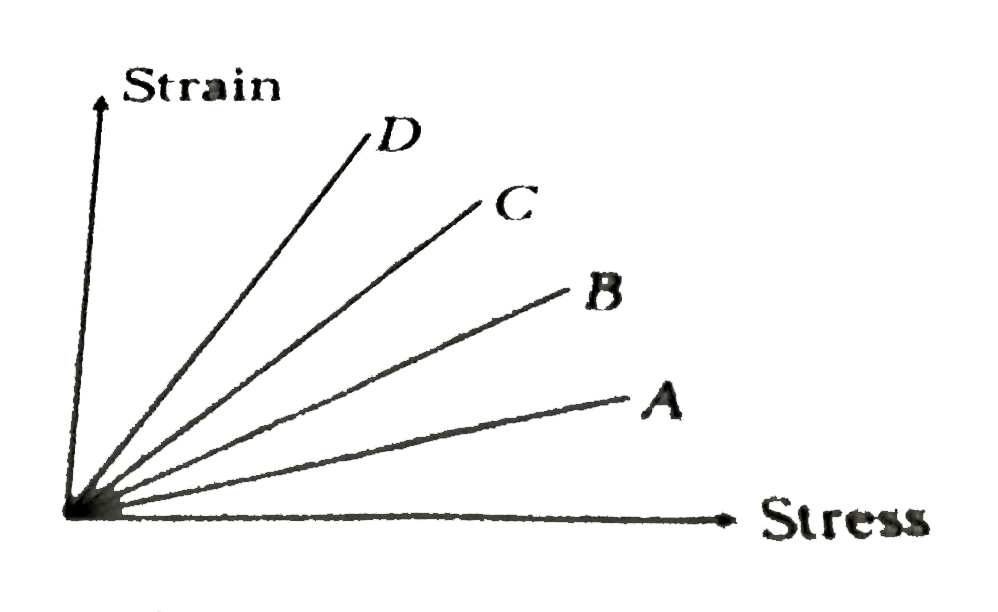isobaric modulus of elasticity is
zero
1
The correct Answer is:B
To find the isobaric modulus of elasticity, we need to understand the definitions and principles involved. Here’s a step-by-step solution:
Step 1: Understand Isobaric Process
- An isobaric process is one in which the pressure remains constant throughout the process. This means that any changes occurring in the system do not involve a change in pressure.
Hint: Remember that "isobaric" directly relates to constant pressure conditions.
Step 2: Define Modulus of Elasticity
- The modulus of elasticity (E or Y) is defined as the ratio of stress to strain. It quantifies how much a material deforms under stress. There are different types of modulus of elasticity:
- Longitudinal modulus (for longitudinal strain)
- Bulk modulus (for volumetric strain)
- Shear modulus (for shear strain)
Hint: Modulus of elasticity is a measure of a material's stiffness.
Step 3: Identify the Relevant Modulus for Isobaric Process
- In the context of an isobaric process, we are interested in the bulk modulus of elasticity (K), which relates to changes in volume under constant pressure.
Hint: Focus on the bulk modulus when dealing with volume changes.
Step 4: Write the Formula for Bulk Modulus
- The bulk modulus (K) is defined as:
K=−dPdVV
where dP is the change in pressure and dVV is the volumetric strain (change in volume divided by original volume).
Hint: The negative sign indicates that an increase in pressure leads to a decrease in volume.
Step 5: Analyze the Isobaric Condition
- Since the process is isobaric, the change in pressure (dP) is zero:
dP=0
Hint: Recognize that if pressure does not change, the bulk modulus will be affected.
Step 6: Substitute into the Bulk Modulus Formula
- Substituting dP=0 into the bulk modulus formula gives:
K=−0dVV=0
Hint: A zero change in pressure leads to a zero value for the bulk modulus.
Conclusion
- Therefore, the isobaric modulus of elasticity is 0.
Final Answer: The isobaric modulus of elasticity is 0.
- An isobaric process is one in which the pressure remains constant throughout the process. This means that any changes occurring in the system do not involve a change in pressure.
- The modulus of elasticity (E or Y) is defined as the ratio of stress to strain. It quantifies how much a material deforms under stress. There are different types of modulus of elasticity:
- Longitudinal modulus (for longitudinal strain)
- Bulk modulus (for volumetric strain)
- Shear modulus (for shear strain)
- In the context of an isobaric process, we are interested in the bulk modulus of elasticity (K), which relates to changes in volume under constant pressure.
- The bulk modulus (K) is defined as:
K=−dPdVV
where dP is the change in pressure and dVV is the volumetric strain (change in volume divided by original volume).
- Since the process is isobaric, the change in pressure (dP) is zero:
dP=0
- Substituting dP=0 into the bulk modulus formula gives:
K=−0dVV=0
- Therefore, the isobaric modulus of elasticity is 0.
Topper's Solved these Questions
Similar Questions
Adiabatic modulus of elasticity of a gas is 2.1×105N/m2. What will be isothermal modulus if elasticity (CpCv=1.4)
View SolutionYoung's modulus of elasticity is the ratio of
View SolutionAssertion Modulus of elasticity does not depend upon the dimensions of material
Reason Modulus of elasticity is a material property.View SolutionAssertion Modulus of elasticity does not depend upon the dimensions of material
Reason Modulus of elasticity is a material property.View SolutionAssertion: From the relation Y =FlAΔl, we can say that, if length of a wire is doubled, its young's modulus of elasticity will also becomes two times.
Reason : Modulus of elasticity is a material property.View Solution(A): Mechanical transverse waves can propagate only in medium with shear modulus of elasticity
(B) : Longitudinal waves need bulk modulus of elasticity and are therefore possible in all media, solids, liquids and gasesView SolutionStress-strain curve for four metals are shown in figure. The maximum Young's modulus of elasticity is for metal
 View Solution
View SolutionAssertion Young's modulus of elasticity is not defined for liquids.
Reason Liquids cannot be stretched as wires.View SolutionThe modulus of elasticity is dimensionally equivalent to
View SolutionAssertion Bulk modulus of elasticity of gases is pressure dependent.
Reason More the pressure of gas, more is the Bulk modulus of elasticity of gas.View Solution

